Related Research Articles

In evolutionary ecology, a parasitoid is an organism that lives in close association with its host at the host's expense, eventually resulting in the death of the host. Parasitoidism is one of six major evolutionary strategies within parasitism, distinguished by the fatal prognosis for the host, which makes the strategy close to predation.

Daucus carota, whose common names include wild carrot, European wild carrot, bird's nest, bishop's lace, and Queen Anne's lace, is a flowering plant in the family Apiaceae. It is native to temperate regions of the Old World and was naturalized in the New World.

The Tachinidae are a large and variable family of true flies within the insect order Diptera, with more than 8,200 known species and many more to be discovered. Over 1,300 species have been described in North America alone. Insects in this family commonly are called tachinid flies or simply tachinids. As far as is known, they all are protelean parasitoids, or occasionally parasites, of arthropods, usually other insects. The family is known from many habitats in all zoogeographical regions and is especially diverse in South America.

Dermestidae are a family of Coleoptera that are commonly referred to as skin beetles. Other common names include larder beetle, hide or leather beetles, carpet beetles, and khapra beetles. There are over 1,800 species described.
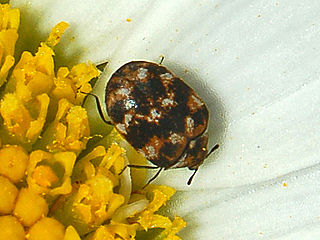
The varied carpet beetle is a 3 mm-long beetle belonging to the family Dermestidae. They are a common species, often considered a pest of domestic houses and, particularly, natural history museums, where the larvae may damage natural fibers and can damage carpets, furniture, clothing, and insect collections. A. verbasci was also the first insect to be shown to have an annual behavioral rhythm and to date remains a classic example of circannual cycles in animals.

Cockroaches are insects belonging to the order Blattodea (Blattaria). About 30 cockroach species out of 4,600 are associated with human habitats. Some species are well-known as pests.

Parasitoid wasps are a large group of hymenopteran superfamilies, with all but the wood wasps (Orussoidea) being in the wasp-waisted Apocrita. As parasitoids, they lay their eggs on or in the bodies of other arthropods, sooner or later causing the death of these hosts. Different species specialise in hosts from different insect orders, most often Lepidoptera, though some select beetles, flies, or bugs; the spider wasps (Pompilidae) exclusively attack spiders.

The superfamily Chrysidoidea is a very large cosmopolitan group, all of which are parasitoids or cleptoparasites of other insects. There are three large, common families and four small, rare families. Most species are small, almost never exceeding 15 mm. This superfamily is traditionally considered to be the basal taxon within the Aculeata, and, as such, some species can sting, though the venom is harmless to humans.

The khapra beetle, also called cabinet beetle, which originated in South Asia, is one of the world's most destructive pests of grain products and seeds. It is considered one of the 100 worst invasive species in the world. Infestations are difficult to control because of the insect's ability to survive without food for long periods, its preference for dry conditions and low-moisture food, and its resistance to many insecticides. There is a federal quarantine restricting the importation of rice into the U.S. from countries with known infestations of the beetle. Khapra beetle infestation can spoil otherwise valuable trade goods and threaten significant economic losses if introduced to a new area. Handling or consuming contaminated grain and seed products can lead to health issues such as skin irritation and gastrointestinal distress.

The mullein moth is a noctuid moth with a Palearctic distribution. The species was first described by Carl Linnaeus in his landmark 1758 10th edition of Systema Naturae.
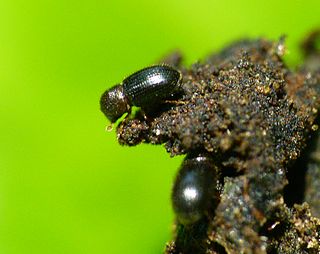
Hypothenemus hampei, the coffee berry borer, is a small beetle native to Africa. It is the most harmful insect pest of coffee worldwide. Spanish common names of the insect include barrenador del café, gorgojo del café, and broca del café.
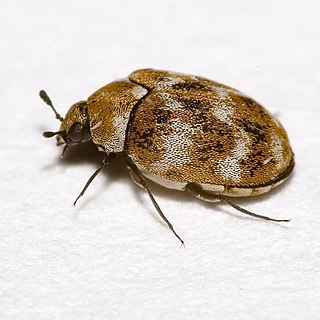
Anthrenus is a genus of beetles in the family Dermestidae, the skin beetles. One of several genera of carpet beetles, Anthrenus was historically placed in a subfamily Anthreninae, though presently included in the Megatominae. The genus Neoanthrenus is closely related.

Megatominae is a subfamily of the beetle family Dermestidae. This subfamily contains several of the most well-known household and stored-product pest beetles, in the genera Anthrenus and Trogoderma.
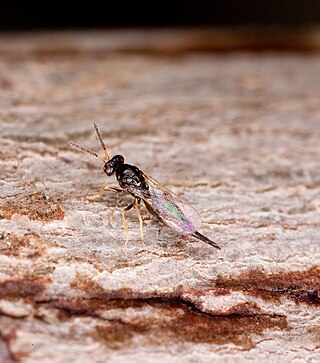
Tetrastichus planipennisi is a parasitic non-stinging wasp of the family Eulophidae which is native to North Asia. It is a parasitoid of the emerald ash borer, an invasive species which has destroyed tens of millions of ash trees in its introduced range in North America. As part of the campaign against the emerald ash borer (EAB), American scientists in conjunction with the Chinese Academy of Forestry searched since 2003 for its natural enemies in the wild leading to the discovery of several parasitoid wasps, including Tetrastichus planipennisi which is a gregarious endoparasitoid of EAB larvae on Manchurian Ash and has been recorded to attack and kill up to 50 percent of EAB larvae.
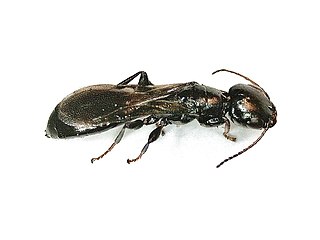
The Bethylidae are a family of aculeate wasps in the superfamily Chrysidoidea. As a family, their biology ranges between parasitoid wasps and hunting wasps.
The Scolebythidae are a small family of aculeate wasps in the superfamily Chrysidoidea. These chrysidoid wasps are found in Africa, Australia, the Neotropics, north China, Thailand and Fiji. They are parasites on larvae of Cerambycidae and Ptinidae.
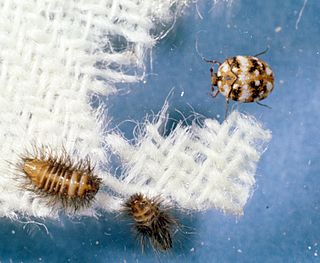
Anthrenus flavipes is a species of beetle in the family Dermestidae known by the common name furniture carpet beetle. It has a cosmopolitan distribution, occurring throughout the world, being most active in warmer climates. It is a pest that damages household materials such as textiles.
Holepyris sylvanidis, is a species of hymenopteran parasitoid in the family Bethylidae. It parasitizes pests of stored products. Its hosts include the confused flour beetle, red flour beetle, sawtoothed grain beetle, merchant grain beetle, and rusty grain beetle.
Laelius is a genus of hymenopteran parasitoids in the family Bethylidae. Laelius species are ectoparasitoids of immature stages of beetles, such as Dermestidae, and thus are commonly taken indoors. There are 57 extent species worldwide and 4 additional species known from fossil records in amber. A number of species have recently been moved from the genus Rhabdepyris to Laelius.
Cephalonomia tarsalis is a idiobiont ectoparasitoid hymenopteran in the family Bethylidae. Known hosts include: Oryzaephilus surinamensis, Sitophilus granarius, Sitophilus oryzae, Sitophilus zeamais, and Tribolium castaneum.
References
- ↑ Mertins, J.W. (1980). "Life history and behavior of Laelius pedatus, a gregarious bethylid ectoparasitoid of Anthrenus verbasci". Annals of the Entomological Society of America. 73 (6): 686–693. doi:10.1093/aesa/73.6.686.
- ↑ Amante, Marco; Schöller, Matthias; Suma, Pompeo; Russo, Agatino (2017). "Bethylids attacking stored‐product pests: an overview". Entomologia Experimentalis et Applicata. 163 (3): 251–264. doi: 10.1111/eea.12587 . S2CID 90311309.
- ↑ Barbosa, D.N.; Azevedo, C.O. (2014). "Revision of the Neotropical Laelius (Hymenoptera: Bethylidae) with notes on some Nearctic species". Zoologia. 31 (3): 285–311. doi: 10.1590/S1984-46702014000300012 . S2CID 84480677.